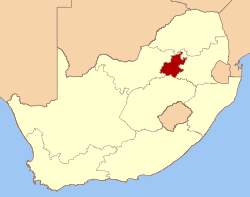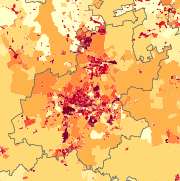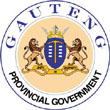Gauteng
| Gauteng | |
|---|---|
| — Province of South Africa — | |
| The Province of Gauteng | |
| Motto: Unity in Diversity | |
 |
|
| Country | |
| Established | 27 April 1994 |
| Capital | Johannesburg |
| Districts |
List
City of Johannesburg
City of Tshwane Ekurhuleni Sedibeng Metsweding West Rand |
| Government | |
| - Type | Parliamentary system |
| - Premier | Nomvula Mokonyane (ANC) |
| Area[1] | |
| - Total | 17,010 km2 (6,567.6 sq mi) |
| Area rank | 9th in South Africa |
| Highest elevation | 1,913 m (6,276 ft) |
| Population (2009)[2] | |
| - Total | 10,531,300 |
| - Rank | 1st in South Africa |
| - Density | 619.1/km2 (1,603.5/sq mi) |
| - Density rank | 1st in South Africa |
| Population groups[3] | |
| - Black African | 75.2% |
| - White | 18.4% |
| - Coloured | 3.7% |
| - Indian or Asian | 2.7% |
| Languages[4] | |
| - Zulu | 21.1% |
| - Afrikaans | 13.6% |
| - Sotho | 12.6% |
| - English | 12.0% |
| - Northern Sotho | 11.2% |
| Time zone | SAST (UTC+2) |
| ISO 3166 code | ZA-GP |
| Website | www.GautengOnline.gov.za |
Gauteng (English pronunciation: /ɡaʊˈtɛŋ/[5] or /xaʊˈtɛŋ/; Sotho pronunciation [xɑ́.ú.ˈtʼè.ŋ̀]) is one of the nine provinces of South Africa. It was formed from part of the old Transvaal Province after South Africa's first all-race elections on 27 April 1994. It was initially named Pretoria-Witwatersrand-Vereeniging (or PWV) and was renamed 'Gauteng' in December 1994.
Situated in the heart of the Highveld, Gauteng is the smallest province in South Africa, with only 1.4% of the land area[6], but it is highly urbanised, containing the cities of Johannesburg and Pretoria. As of 2007[update], it had a population of nearly 10.5 million, making it the most populous province in South Africa.[7]
Contents |
Etymology
The name Gauteng comes from the Sesotho word meaning "Place of Gold", the historical Sesotho name for Johannesburg and surrounding areas. This referred to the thriving gold industry in the province following the 1886 discovery of gold in Johannesburg.[6] The Sesotho word is a locative derived from the Afrikaans goud (gold) plus the locative suffix "-ng." When properly pronounced, the first letter of the name Gauteng is a voiceless velar fricative, pronounced similarly to the "ch" in the German achtung or Scottish loch. This pronunciation is natural in both the Sesotho and Afrikaans languages.
History
Gauteng, formerly known as Pretoria-Witwatersrand-Vereeniging (PWV), was carved out of the old Transvaal province in 1994. Tokyo Sexwale was elected as the first premier of the province that same year. Politically, it has been dominated by the ANC throughout its post-apartheid history.
Law and Government
Since 6 May 2009, the premier has been Nomvula Mokonyane. Paul Mashatile, the former provincial minister of finance and economic affairs and the current provincial chairman of ANC in the Gauteng Province, was Premier from 7 October 2008 until Mokonyane's election. He replaced former premier Mbhazima Shilowa, who was premier from 1999. Shilowa resigned in protest against the decision by the ANC national executive committee (NEC) to remove former president Thabo Mbeki from office. Both Mashatile and Shilowa are from the African National Congress.
Geography & Climate
Gauteng's southern border is the Vaal River, which separates it from the Free State. It also borders on North West to the west, Limpopo to the north, and Mpumalanga to the east. Gauteng is the only landlocked province of South Africa without a foreign border. Most of Gauteng is on the Highveld, a high-altitude grassland (circa 1,500 m above sea-level). Between Johannesburg and Pretoria there are low parallel ridges and undulating hills, some part of the Magaliesberg Mountains and the Witwatersrand. The north of the province is more subtropical, due to its lower altitude and is mostly dry savanna habitat.
The climate is mostly influenced by altitude. Even though the province is at a subtropical latitude, the climate is comparatively cooler, especially in Johannesburg, at 1,700 m above sea level (Pretoria is at 1,330m). Most precipitation occurs as brief afternoon thunderstorms; however, relative humidity never becomes uncomfortable. Winters are crisp and dry with frost occurring often in the southern areas. Snow is rare, but it has occurred on some occasions in the Johannesburg metropolitan area.
- Johannesburg averages: January maximum: 26°C (min: 15°C), June maximum: 16°C (min: 4°C), annual precipitation: 713 mm
- Pretoria averages: January maximum: 29°C (min: 18°C), June maximum: 19°C (min: 5°C), annual precipitation: 674 mm
Municipalities

Gauteng Province is divided into 3 metropolitan municipalities, and 3 district municipalities which are further divided into 9 local municipalities). [2]
|
|
|
See also: List of cities and towns in Gauteng
Demographics

| <1 /km² 1–3 /km² 3–10 /km² 10–30 /km² 30–100 /km² | 100–300 /km² 300–1000 /km² 1000–3000 /km² >3000 /km² |
Gauteng Province is home to 8.8 million people (2001 South African National Census), almost 20% of the total South African population. Gauteng Province is also the fastest growing province, experiencing a population growth of over 20% between the 1996 and 2001 censuses, thus Gauteng is likely to soon have the highest population of any province in South Africa.
As of the census of 2001, there are 8,837,172 people and 2,651,243 households residing in Gauteng. The population density is 519.53/km². The density of households is 155.86/km².
About 22.1% of all households are made up of individuals. The average household size is 3.33.
The province's age distribution was 23.6% under the age of 15, 19.6% from 15 to 24, 37.9% from 25 to 44, 15.0% from 45 to 64, and 4.0% who are 65 years of age or older. The median age is 27 years. For every 100 females there are 101.2 males. For every 100 females age 18 and over, there are 102.3 males.
In the province, 14.4% of residents speak Afrikaans at home, 12.5% speak English, 1.5% speak IsiNdebele, 7.3% speak IsiXhosa, 20.5% speak IsiZulu, 10.7% speak Sepedi, 13.1% speak Sesotho, 8.4% speak Setswana, 1.2% speak SiSwati, 4.2% speak Tshivenda, and 5.1% speak Xitsonga. 1.0% of the population speaks a non-official language at home.
76.0% of residents are Christian, 18.4% have no religion, 1.7% are Muslim, 0.5% are Jewish, and 0.8% are Hindu. 2.6% have other or undetermined beliefs.
8.4% of residents aged 20 and over have received no schooling, 11.2% have had some primary school, 5.5% have completed only primary school, 34.3% have had some high school education, 28.0% have finished only high school, and 12.6% have an education higher than the high school level. Overall, 40.6% of residents have completed high school.
56.1% of housing units have a telephone and/or cell-phone in the dwelling, 41.5% have access to a phone nearby, and 2.3% have access that is not nearby or no access. 82.8% of households have a flush or chemical toilet. 84.2% have refuse removed by the municipality at least once a week and 2.6% have no rubbish disposal. 47.2% have running water inside their dwelling, 83.6% have running water on their property, and 97.5% have access to running water. 73.2% of households use electricity for cooking, 70.4% for heating, and 80.8% for lighting. 77.4% of households have a radio, 65.7% have a television, 15.1% own a computer, 62.1% have a refrigerator, and 45.1% have a cell-phone.
25.8% of the population aged 15–65 is unemployed.
The median annual income of working adults aged 15–65 is R 23 539 ($3,483). Males have a median annual income of R 24 977 ($3,696) versus R 20 838 ($3,083) for females. The annual income distribution in Gauteng Province is:
- No income 2.0%
- R 12 – R 4 800 ($2 – $721) 6.4%
- R 4 812 – R 9 600 ($723 – $1,443) 13.0%
- R 9 612 – R 19 200 ($1,445 – $2,886) 24.0%
- R 19 212 – R 38 400 ($2,888 - $5,772) 20.4%
- R 38 412 – R 76 800 ($5,774 - $11,543) 15.8%
- R 76 812 – R 153 600 ($11,545 - $23,087) 10.4%
- R 153 612 – R 307 200 ($23,089 - $46,174) 5.0%
- R 307 212 – R 614 400 ($46,176 - $92,348) 1.8%
- R 614 412 or more ($92,350+) 1.1%
Statistics South Africa Census 2001
Approximately half of the 2200 Filipinos in South Africa live in the province.[8]
Economy
Gauteng is considered the economic hub of South Africa and contributes heavily in the financial, manufacturing, transport, technology and telecommunications sectors, amongst others. It also plays host to a large number of overseas companies requiring a commercial base in and gateway to Africa.
Although Gauteng is the smallest of South Africa's nine provinces - it covers only 1.4% of the country's total land area - it contributes 33.9% of its gross domestic product (GDP). Indeed Gauteng generates 10% of the GDP of the entire African continent[9].
Future growth

Gauteng is growing rapidly, due to mass urbanisation that is a feature of many developing countries. According to the State of the Cities Report, the urban portion of Gauteng - comprised primarily of the cities of Johannesburg, Ekurhuleni (the East Rand) and Tshwane (greater Pretoria) - will be a polycentric urban region with a projected population of some 14.6 million people by 2015, making it one of the largest cities in the world. AIDS may however negate this projection.
This rapid growth has brought with it both opportunities and challenges. As a global focal point, with access to the Southern African hinterland, Gauteng has the ability to link the world to a population approximately the same size as the United States. It is fast becoming to sub-Saharan Africa what the Eastern Seaboard megalopolis is to America. This also presents some formidable obstacles, most notably the ability to provide access to basic amenities such as electricity and potable water. Transport is also a major problem, and Johannesburg, as the core of Gauteng, is beginning to experience the heavy traffic problems of cities such as Los Angeles and Bangkok. The Gautrain Rapid Rail Link is an attempt to remedy this problem, by providing efficient high-speed rail between Pretoria, Sandton, Johannesburg and OR Tambo International Airport; completion due 2010.
In May and June 2008 Gauteng, along with other provinces within South Africa, saw extremely violent xenophobic attacks on foreigners. The instigating factors of these attacks have been largely attributed to the South African Government's inability to deal with the massive influx of foreign nationals and its poor service delivery.
Education

Gauteng is a centre of learning in South Africa, and it has many universities and other schools of higher learning.
- University of Limpopo (Formed after the merger of Medical University of South Africa and University of the North)
- Tshwane University of Technology (Formed after Technikon Pretoria, Technikon Northern Gauteng, and Technikon North-West merged)
- University of Johannesburg (Formed after Rand Afrikaans University, some Johannesburg campuses of Vista University and Technikon Witwatersrand merged)
- University of Pretoria which also include the former campus of Mamelodi Vista University
- University of South Africa: Also known as UNISA and incorporating the Technikon South Africa and the distance learning unit of Vista University
- Vaal University of Technology: Previously known as Vaal Triangle Technikon
- University of the Witwatersrand
- Regenesys Management
- Monash University South Africa Campus
Gauteng Department of Education has embarked on a project to provide fully functional ICT laboratories to all public schools in Gauteng. The name of this project is Gauteng OnLine
Conservation
Although Gauteng province is dominated by the urban areas of Johannesburg and Pretoria, it has some beautiful nature reserves.
Botanical Gardens
- Walter Sisulu National Botanical Garden
- Johannesburg Botanical Garden
- Pretoria National Botanical Garden
Provincial reserves
There are 5 provincial reserves managed by the Gauteng Department of Agriculture, Conservation, Environment and Land Affairs
- Abe Bailey Nature Reserve
- Alice Glockner Nature Reserve
- Marievale Bird Sanctuary
- Roodeplaat Nature Reserve
- Suikerbosrand Nature Reserve
Private and Municipal Reserves
- Kromdraai Conservancy
- Krugersdorp Nature Reserve
- Rietvlei Nature Reserve
- Wonderboom Nature Reserve
Gauteng is also home to the Cradle of Humankind UNESCO World Heritage Site
Sport and recreation
The national sport of South Africa is best considered association football, more commonly known in South Africa as "soccer". Several teams from Gauteng play in the country's top-level league, the Premier Soccer League (PSL), including Kaizer Chiefs and Orlando Pirates.
Rugby, or more accurately rugby union, is also a popular sport in South Africa, and in Gauteng in particular. Two rugby teams from Gauteng participate in the Southern Hemisphere Super 14 championship: the Pretoria-based Bulls, and the Johannesburg-based Lions (previously the Cats). Three Gauteng-based teams play in the country's domestic competition, the Currie Cup: the Blue Bulls from Pretoria, the Golden Lions from Johannesburg and the Falcons from the East Rand.
Cricket is also widely popular among all cultural groups in the country, and is the only sport to feature in the top two among all of South Africa's major ethnic/racial groups. The Highveld Lions represent both Gauteng and North West in the country's three domestic competitions—the first-class SuperSport Series, the List A one-day MTN Domestic Championship and the Twenty20 Standard Bank Pro 20 Series.
Popular individual sports include tennis and golf.
Walking and Hiking are also popular in Gauteng. But high crime rates and urban neglect have made it difficult and often dangerous to walk in the parks and greenbelts. For more info on walking in Gauteng, have a look at Gauteng Dogwalks homepage - it has photos, maps and more info on getting people safely back into the province's parks.
There are some interesting tourist attractions too: the Sterkfontein caves, and the Wonder Cave Kromdraai are in the Cradle of Humankind World Heritage Site.
See also: Vodacom Cup
See also
- List of Speakers of the Gauteng Provincial Legislature
- PWV
References
http://www.mg.co.za/article/2008-10-07-mashatile-elected-to-lead-gauteng
- ↑ Burger, Delien, ed (2009). "The land and its people". South Africa Yearbook 2008/09. Pretoria: Government Communication & Information System. p. 20. ISBN 978-0-621-38412-3. http://www.gcis.gov.za/resource_centre/sa_info/yearbook/2009/chapter1.pdf. Retrieved 23 September 2009.
- ↑ "Mid-year population estimates 2009" (HTML). Statistics South Africa. p. 4. http://www.statssa.gov.za/publications/statsloading.asp?PPN=P0302&SCH=4437. Retrieved 11 June 2010.
- ↑ "Statistical release P0301: Community Survey, 2007 (Revised version)" (PDF). Statistics South Africa. p. 25. http://www.statssa.gov.za/publications/P0301/P0301.pdf. Retrieved 7 October 2009.
- ↑ "Table: Census 2001 by province, language, population group and gender.". Census 2001 Interactive Tables. Statistics South Africa. http://www.statssa.gov.za/timeseriesdata/pxweb2006/Dialog/varval.asp?ma=Language%20by%20province&ti=Table%3A+Census+2001+by+province%2C+language%2C+population+group+and++gender%2E&path=../Database/South%20Africa/Population%20Census/Census%202001%20-%20NEW%20Demarcation%20boundaries%20as%20at%209%20December%202005/Provincial%20level%20-%20Persons/&lang=1. Retrieved 28 January 2010.
- ↑ Merriam-Webster Online.[1] They transcribe it /ˈɡaʊtɛŋ/, with the stress on the first syllable, but the audio file is /ɡaʊˈtɛŋ/, with the stress on the second; the latter more closely matches the Sotho.
- ↑ 6.0 6.1 "About Gauteng". Gauteng Provincial Government. http://www.gpg.gov.za/frames/gallery-f.html. Retrieved 2008-10-25.
- ↑ "Community Survey 2007: Basic results" (PDF). Statistics South Africa. p. 2. http://www.statssa.gov.za/publications/CS2007Basic/CS2007Basic.pdf. Retrieved 23 September 2009.
- ↑ "No Filipinos reported hurt, killed in South Africa--DFA". Global Inruirer. 2008-05-23. http://globalnation.inquirer.net/news/breakingnews/view/20080523-138414/No-Filipinos-reported-hurt-killed-in-South-Africa--DFA. Retrieved 2009-02-18.
- ↑ Gauteng Economic Development Agency
- ↑ https://www.up.ac.za/dspace/handle/2263/6561 Old Arts Building. Retrived September 18, 2009
External links
|
||||||||||||||
|
|||||||||


